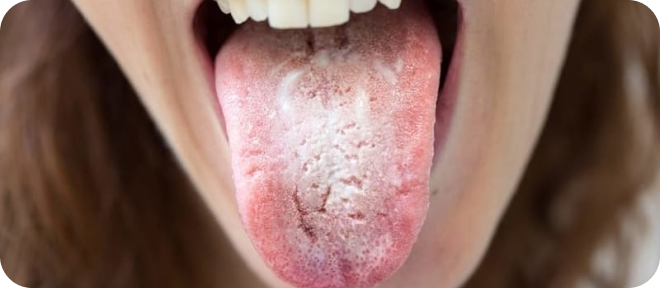Oral candidiasis is a type of yeast infection in which the oral mucosa is affected by yeast-like fungi of the genus Candida (primarily Candida albicans). The main symptom of candida is the appearance of a whitish coating on the mucous membrane that resembles snowflakes or cheese. Candida can occur on the mucous membrane of the tongue, cheeks, hard and soft palate, tonsils, palatal arches and in the corners of the mouth. Candida can also appear in the throat.
In dentistry, the professional term for this disease is accepted - oral candidiasis. Most often, this disease develops with reduced immunity, equally in men and women. Candidiasis in the mouth can also develop in infants, and most often occurs in the 4th week after birth (less often in the 1st week, or in children older than 6 months).
It is important to understand that oral candidiasis in adults or infants is not some banal fungal infection of the mucous membrane that you can accidentally get infected with and just as easily and quickly cure. Fungi from the genus Candida are ''opportunistic microorganisms'' and cause an infection of the oral cavity - only if the 'owner' has a predisposing condition. Yeast-like fungi are part of the normal microflora of the human oral cavity, and in most cases never show their pathogenic properties.
Oral candidiasis is most often a marker of serious (not yet diagnosed) diseases and pathologies of the immune system. If before 1980 candida in the mouth occurred mostly only in very young or elderly patients, now due to the widespread prevalence of immunodeficiency conditions (diabetes mellitus, leukemia, HIV/AIDS) and the widespread use of immunosuppressive drugs - oral candidiasis is typical for any era.
Oral Candidiasis Causes
There are many subspecies of the genus Candida. Previously, candidiasis in the mouth was caused by the species Candida Albicans in about 80% of cases, and only in other cases by the more pathogenic species C. glabrata, C. krusei, C. tropicalis. Now C.albicans is the cause of candidiasis in only 50% of patients, i.e. the most aggressive types of Candida fungi, which are resistant to many antifungal drugs, are increasingly becoming the causative agents of candidiasis.
We have already said that the main reason for the appearance of candida in the mouth is a weakened immune system. This is typical for patients taking systemic antibiotics, corticosteroids, for patients with immunodeficiency conditions - patients with diabetes, blood diseases (neutropenia, anemia), intestinal dysbiosis, as well as for patients with HIV (in the latter, oral candidiasis is diagnosed in 90% of cases). At risk are patients with oncological diseases, including those after chemotherapy and radiation therapy), as well as women taking oral contraceptives.
.jpg)
Candidiasis of the mouth after taking antibiotics
The oral cavity usually contains many types of microorganisms that not only coexist, but also inhibit each other's growth. Taking broad-spectrum antibiotics eliminates some types of bacteria in the oral cavity, which disrupts the balanced composition of the microflora. The disappearance or reduction of certain types of bacteria can lead to the growth of Candida fungi.
Candidiasis of the mouth when taking corticosteroids
In patients with diabetes and asthma, the use of inhaled corticosteroids can cause oral candidiasis. According to statistics, candida in the oral cavity occurs in approximately 5-10% of adults and 1% of children who use inhaled corticosteroids. In cases where inhaled steroids are the cause of this disease, the candidal lesions usually have an erythematous (reddened) appearance, not a snowflake.
Candida lesions appear precisely on those parts of the mucous membrane with which the steroid came into contact (as a rule, this is the back of the tongue, the palate). For this reason, patients taking such drugs are advised to rinse their mouth with water after each use of corticosteroids.
Diet
Studies show that a diet high in carbohydrates also predisposes to oral candidiasis, so it is very important for such patients to avoid sweets, including sugary drinks. Research shows that the growth of Candida and its adhesion to the mucous membrane is significantly enhanced in the presence of sugar (glucose, galactose, sucrose).
It should also be taken into account that malnutrition can lead to a lack of iron, vitamin B12 and folic acid in the body, which is also a predisposing factor for oral candidiasis.
Smoking and other factors
Other factors may include smoking, endocrine disorders (such as diabetes mellitus), the presence of certain diseases of the oral mucosa, such as lichen planus and leukoplakia. Oral candidiasis often occurs in patients with a folded tongue or after tongue piercing.
Mobile prostheses
In patients with mobile prostheses, candidiasis occurs due to insufficient hygiene of the prostheses. In this case, the prosthesis is covered with a biofilm containing a large number of Candida fungi. At the same time, during chewing, the mobile prosthesis adheres to the mucous membrane of the prosthetic bed, reducing its barrier properties (this facilitates the penetration of fungal microflora into the depth of the mucous membrane). For this reason, disinfection of dentures is a very important part of the prevention and treatment of oral candidiasis in people with removable dentures.
A predisposing factor may be if the patient does not remove his prosthesis while sleeping. In this case, the mucous membrane is constantly deprived of oxygen and saliva, which creates prerequisites for the reproduction of bacteria and fungi. Another reason may be that the prosthesis does not fit well with the tissues of the prosthetic bed, thus injuring the mucous membrane. Such mucosal microtraumas also contribute to the development of oral candidiasis.
Chronic dry mouth
A reduced amount of saliva and the content of various enzymes and antibodies in the oral cavity is an important predisposing factor in the development of oral candidiasis. Dentists call constant dryness in the mouth xerostomia.
Poor oral hygiene
Rotten teeth, caries and improper tooth brushing increase the risk of developing candidiasis. Infection in carious defects, soft microbial plaque, hard dental deposits - worsen the local immunity of the oral mucosa. Therefore, fungi of the genus Candida begin to multiply actively and can penetrate deep into the oral mucosa.
Symptoms of candida in the mouth
When oral candida occurs in adults, symptoms can vary significantly from patient to patient. The fact is that oral candidiasis manifests itself through three main types, each of which has characteristic special symptoms. The following 3 main forms of this disease are distinguished:
- acute pseudomembranous candidiasis,
- acute or chronic atrophic candidiasis,
- chronic hyperplastic candidiasis.
Below we will analyze the characteristics of each form, but, despite the differences in symptoms, their treatment will be carried out in almost the same way.
1) Acute pseudomembranous candidiasis
This form of oral candidiasis is usually asymptomatic. Discomfort may occur due to the presence of white coating or plaques that rise above the oral mucosa. In mild cases, the plaques are single, easily removed, and under them is a bright red mucous membrane.
In severe cases, the plaques, increasing in size, merge with each other, which leads to the involvement of almost the entire surface of the mucous membrane.
2) Acute and chronic atrophic candidiasis
In acute atrophic candidiasis, the patient may feel as if he has been scalded by a hot liquid. There are no white plaques in this case, and the mucous membrane has a bright red color. Another possible symptom is a metallic, sour, salty or bitter taste in the mouth, as well as dry mouth. Most often, acute atrophic candidiasis develops after taking broad-spectrum antibiotics or inhaled corticosteroids.
With chronic atrophic candidiasis, there is also redness of the mucous membrane, a burning sensation. Most often, this form of candidiasis occurs in patients with mobile dentures, so it is sometimes called prosthetic stomatitis. In some classifications, atrophic candidiasis can also be called the term 'erythematous' (from the word 'erythem' - redness).
3) Chronic hyperplastic candidiasis
It occurs mainly only in adults and is quite rare (compared to other forms of candidiasis, the frequency of occurrence does not exceed 5%). It most often occurs on the mucous membrane of the cheeks, near the corners of the mouth, on the back of the tongue, as well as on the soft palate. It is characterized by the appearance of white plaques that grow and merge over time, gradually acquiring a yellowish color. In the expressed phase, the surface of the plaques becomes rough, knotty.
Hyperplastic candidiasis differs from pseudomembranous candidiasis in that the plaques in this case can no longer be removed by careful scraping. Most often, hyperplastic candidiasis occurs in middle-aged men who smoke. There are studies that prove that hyperplastic candidiasis tends to transform into cancer. This type of candidiasis can be considered a precancerous disease.
Important: Most types of oral candidiasis are painless, and are manifested only by the presence of lesions on the oral mucosa, sometimes there may be a burning sensation. This is why candidiasis can sometimes be misdiagnosed as 'burning syndrome'.
In order to make an accurate diagnosis, it is very important to perform a cytological examination of the plaque taken from the oral mucosa. This is all the more important because very often an abundant accumulation of non-fungal microflora (especially on the tongue) - can resemble a fungal infection of the mucous membrane.

Complications of oral candidiasis
Very often, adults resort to self-medication, which often only leads to the spread of the fungal infection. Candidiasis in the mouth can quickly lead to the appearance of Candida in the throat, it can spread to the esophagus, causing esophagitis (pain when food passes through the esophagus, which feels like chest pain).
Also, oral candidiasis that is not treated in time can lead to the spread of the process to the skin (chronic mucocutaneous candidiasis), which mainly occurs in patients with pathologies of the immune system, i.e. with defects in the functioning of T-lymphocytes, with neutropenia. Lack of treatment or untimely treatment of the hyperplastic form of candidiasis can lead to the development of cancer in the oral cavity.
Treatment of candidiasis
We have already mentioned that oral candidiasis is less and less caused by the Candida albicans subspecies, which responds quite well to antifungal therapy. The most aggressive types of Candida fungi - such as C. glabrata, C. krusei and C. tropicalis - are increasingly developing in patients, which not only show resistance to many antifungal drugs, but also increasingly combine with other microorganisms (staphylococci, streptococci etc.). All this complicates treatment, and also contributes to the development of relapse.
Therefore, the most important thing before treatment is to carry out a cytological examination. In this way, you will confirm the diagnosis of oral candidiasis, and in addition, determine the sensitivity of Candida fungi to the main antifungal drugs. These are systemic antifungal drugs that will be the basis for the treatment of oral candidiasis. Treatment of mild primary forms of the disease can be carried out using local agents.
Treatment of oral candidiasis lasts an average of 12-15 days (until the symptoms of the disease disappear completely). However, in patients with chronic candidiasis who already have relapses, maintenance therapy will also be required. The treatment of the disease should be carried out by a dentist - in cooperation with doctors of other specialties (therapist, gynecologist, mycologist).

Important items in the treatment of oral candidiasis
There are several problems that can occur during the treatment of candidiasis.
The first problem is that fungi of the genus Candida can be located not only on the surface of the epithelial cells of the mucous membrane, but can also grow inside the epithelial cells. In this case, the mucopolysaccharide membrane of the host cell will protect the fungi not only from phagocytes (which must find, absorb and digest infectious agents), but also, to some extent, from antifungal drugs. In this case, higher doses of drugs and longer courses of treatment (including suppressive therapy) may be required.
Another problem can be the insufficiency of the immune response (for example, incomplete phagocytosis of Candida fungi). In the absence of immunocorrection with the help of immunomodulators, this drastically increases the risk of developing chronic candidiasis and subsequent relapses.
It is very important to carry out the treatment with the simultaneous rehabilitation of the oral cavity, i.e. it is necessary to cure all decayed teeth, foci of chronic inflammation in the oral cavity, remove plaque. If the soft microbial plaque and hard dental deposits are not removed, this means that a new recurrence of oral candidiasis will occur very quickly. In addition, it is important for patients with removable dentures to regularly disinfect their dentures, as well as replace them if they have expired. It will be futile to treat oral candidiasis in patients whose dentures continue to be a source of infection.
In this case, it is very important for smokers to reduce the frequency of nicotine consumption. If candidiasis occurs during the use of inhaled steroids (in asthmatics), the patient should rinse the mouth with water after spraying the steroid. During treatment, it is also very important to reduce the amount of carbohydrates consumed, and it is preferable to completely eliminate sweet drinks and drinks containing sugar. For patients with dry mouth, it is important to start using special preparations to keep the oral mucosa hydrated.
Toothpastes containing lactoferrin, lactoperoxidase, lysozyme, and glucose oxidase can be of great help in the treatment and prevention of candidiasis and stomatitis. Such pastes increase the local immunity of the oral cavity, reduce the risk of developing stomatitis and candidiasis.
Another point is to increase the amount of food consumed that can suppress the development of Candida. The growth of fungi can be controlled with natural yogurts containing live cultures of lactic acid, as well as products with natural anti-fungal activity (garlic, propolis, hot red pepper).
Important: If your oral candidiasis is prone to regular recurrences, then it is best to undergo a complete body examination (the primary reservoir of Candida fungi is most often the gastrointestinal tract). In addition, candidiasis can be a marker of a serious disease that you may not even be aware of. It can be blood diseases, endocrine disorders, gastrointestinal diseases, it can even be a sign of oncology.
Frequently asked questions about candida:
Candida in the mouth: symptoms and treatment:
The presence of candida in the mouth is not uncommon, but if it overgrows, it can lead to discomfort and health problems. Symptoms include a whitish coating on the tongue and palate, bad breath and pain when swallowing. Treatment of candida in the mouth usually involves the use of antifungal drugs and a change in eating habits.
Candida in the body: symptoms and against candida
Candida is naturally present in our body, but if there is an overgrowth, it can cause symptoms such as fatigue, bad breath, headaches, skin irritation and digestive problems. Candida can be combated by changing diet and lifestyle, as well as by using antifungal medications.
Candida can affect hormones and health
Scientists have discovered that candida overgrowth can affect hormones, especially estrogen, which can lead to imbalances and health problems like infertility, mood swings, and PMS. Treating candida can help restore hormonal balance and improve health.
Candida in the intestines: causes, symptoms and treatment
Candida overgrowth in the gut can be caused by a number of factors, including unhealthy diet, stress, and antibiotic use. Symptoms include bloating, gas, diarrhea or constipation, fatigue and skin problems. Treatment for candida in the gut usually involves changing your diet, using probiotics, and antifungal medications.
Candida in women: symptoms and how to treat it
Candida can be common in women, especially during pregnancy and after taking antibiotics. Symptoms include itching and burning, a whitish discharge and pain during sex. Treatment of candida in women usually involves topical antifungal drugs and changes in eating habits and hygiene of the intimate region.

.jpg)






Share your opinion!
What do you think about this topic?
Comments (0)